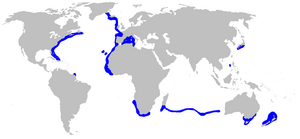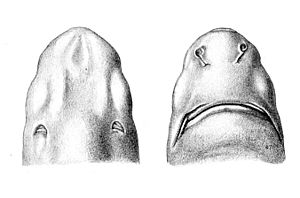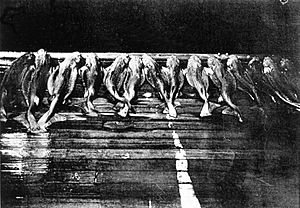Portuguese dogfish facts for kids
Quick facts for kids Portuguese dogfish |
|
|---|---|
 |
|
| Conservation status | |
| Scientific classification | |
| Genus: |
Centroscymnus
|
| Species: |
coelolepis
|
 |
|
| Range of the Portuguese dogfish | |
| Synonyms | |
|
Centroscymnus macrops* Hu & Li, 1982 * ambiguous synonym |
|
The Portuguese dogfish (Centroscymnus coelolepis), also called the Portuguese shark, is a type of sleeper shark. It belongs to the family called Somniosidae. This shark lives all over the world. It has been found as deep as 3,675 m (12,057 ft). This makes it the deepest-living shark we know!
Portuguese dogfish live on the lower parts of continental slopes and deep abyssal plains. They usually stay close to the ocean floor. These sharks are stocky and dark brown. You can tell them apart from similar sharks, like the kitefin shark, by the tiny spines in front of their dorsal fins. Their skin is also special. It has tiny tooth-like dermal denticles that look like the scales of a bony fish. This shark usually grows to be about 0.9–1 m (3.0–3.3 ft) long. However, sharks living in the Mediterranean Sea are much smaller. They also prefer different depths and foods.
The Portuguese dogfish is quite common. It is an active hunter that can catch fast, large prey. It mainly eats cephalopods (like squid) and other fish. But it also eats smaller invertebrates and even whale carrion (dead animals). This shark has amazing eyesight. Its eyes are perfect for seeing the bioluminescence (light made by living things) of its prey. This is important because no sunlight reaches the deep ocean where it lives.
Portuguese dogfish give birth to live young. The babies grow inside the mother, getting food from a yolk sac. Females can have up to 29 babies at a time. Their pregnancy lasts for over a year. People value this shark for its liver oil and, less often, for its meat. Deepwater commercial fisheries in places like Portugal, the British Isles, Japan, and Australia catch them. Because of fishing and their slow reproduction, the International Union for Conservation of Nature (IUCN) lists them as Near Threatened. This means they could become endangered in the future.
Contents
About the Portuguese Dogfish
The Portuguese dogfish was first described by scientists in 1864. Two Portuguese zoologists, José Vicente Barbosa du Bocage and Félix António de Brito Capello, wrote about it. They gave it the scientific name Centroscymnus coelolepis. The name coelolepis comes from Greek words meaning "hollow" and "fish scale." This refers to its unique skin. The first shark they studied, caught off Portugal, was later destroyed in a fire.
Where They Live and Their Home
The Portuguese dogfish is one of the most widespread deepwater sharks. You can find them in many parts of the world. In the western Atlantic, they live from the Grand Banks of Newfoundland down to Delaware in the U.S. In the eastern Atlantic, they are found from Iceland to Sierra Leone. This includes the western Mediterranean Sea, the Azores, and Madeira. They also live off southern Namibia to western South Africa.
In the Indian Ocean, they have been caught near the Seychelles. In the Pacific, these sharks are found off Japan, New Zealand, and Australia. This includes areas from Cape Hawke, New South Wales, to Beachport, South Australia, and Tasmania.
This shark is known to live deeper than any other shark. It has been found from 150 m (490 ft) to 3,675 m (12,057 ft) deep. They are most common between 400 m (1,300 ft) and 2,000 m (6,600 ft). In the Mediterranean Sea, they live even deeper. They are rarely found above 1,500 m (4,900 ft) and are most common at 2,500–3,000 m (8,200–9,800 ft). The deep Mediterranean is warmer and saltier than the deep ocean.
Portuguese dogfish usually stay near the bottom of the ocean. However, young sharks can sometimes be found higher up in the water. Different sizes and sexes of sharks live at different depths. Pregnant females are found in shallower water, above 1,200–1,500 m (3,900–4,900 ft). Younger sharks live deeper. There might be different groups of these sharks in the Atlantic. Sharks in the Mediterranean and off Japan also seem to be unique populations.
What They Look Like
Male Portuguese dogfish typically grow to about 0.9 m (3.0 ft) long. Females are a bit larger, reaching 1.0 m (3.3 ft). Some sharks have been recorded up to 1.2 m (3.9 ft) long. Sharks in the Mediterranean Sea are smaller, usually no more than 65 cm (26 in) long.
This shark has a wide, flat, and rounded snout. Its nostrils have small skin flaps in front of them. Its eyes are large and oval-shaped. They are on the sides of its head and have a special reflective layer. This layer makes their eyes glow yellow-green in the dark. The mouth is wide and slightly curved. It has thick, smooth lips.
The upper teeth are thin and pointed, with a single sharp tip. There are 43 to 68 rows of these teeth. The lower teeth have a short, angled tip. There are 29 to 41 rows of lower teeth. These teeth fit together to form a continuous cutting edge. The shark has five short, vertical gill slits.
The body of the Portuguese dogfish is thick and round, but its belly is flat. It has two small dorsal fins that are similar in size. Each dorsal fin has a tiny grooved spine in front of it. The first dorsal fin is located behind the pectoral fins. The second dorsal fin is above the middle of the pelvic fins. It has medium-sized pectoral fins with rounded edges. This shark does not have an anal fin. Its caudal fin (tail fin) has a short but well-developed lower part. It also has a noticeable notch near the tip of the upper part.
The tiny tooth-like dermal denticles on its skin change as the shark gets older. In young sharks, they are spread out and heart-shaped. They have three points at the back. In adult sharks, they overlap and are round and smooth. They have a round dip in the middle, looking a bit like the scales of bony fishes. Young sharks are a solid blue-black color. Adults are brown-black. Their fins do not have any special markings. In 1997, a partially albino Portuguese dogfish was found. It had a pale body but normal eyes. This was the first time albinism was seen in a deep-sea shark.
Life in the Deep Ocean
The Portuguese dogfish lives almost entirely in the aphotic zone. This is the part of the ocean where little to no sunlight can reach. It is a common shark and often the main shark species in deeper waters. This shark has a very large liver that is full of squalene oil. This oil helps the shark float easily in the water. It means they can hover with very little effort. Males have more squalene in their livers than females.
Studies show that the Portuguese dogfish swims slowly, about 0.072 m/s (0.24 ft/s). They don't stay in one place for long. Larger fish and sharks might hunt them. Some known parasites of this shark include certain flatworms and tapeworms.
The Portuguese dogfish is an active hunter. It preys on mobile and relatively large animals. Its main foods are cephalopods (like squid) and bony fishes. These include slickheads, orange roughy, lantern fishes, and rattails. They also eat other sharks and invertebrates, such as jellyfish. They are also known to scavenge on whale carcasses.
This shark has better vision than many other deep-sea sharks. Its eyes have a large pupil and lens. They also have a reflective layer that helps them see in the dark. Their eyes have many special cells that are good at detecting movement, especially along the horizontal plane. The shark's vision seems to be adapted to see bioluminescence. The light their eyes absorb matches the light given off by their favorite prey, like certain squid.
In the Mediterranean Sea, the Portuguese dogfish is one of the most common deepwater sharks. It lives alongside the blackmouth catshark and the velvet belly lantern shark. It is the only shark that is common below 1,500 m (4,900 ft) deep. By living deeper, Mediterranean Portuguese dogfish might avoid competing for food with these other two species. The smaller size of Mediterranean sharks might be because there is less food available. Or it could be due to the warmer, saltier water there. About 87% of the diet of Mediterranean Portuguese dogfish is made up of cephalopods. Bony fish are a secondary food source. Young sharks prefer a type of shrimp, which is common in their environment. Unlike in other regions, Mediterranean sharks rarely scavenge.
Life Cycle and Reproduction
The Portuguese dogfish gives birth to live young. The female keeps the eggs inside her body until they hatch. The baby sharks get their food from a yolk sac. They might also get nutrients from a fluid produced by the mother. Some studies suggest there are two breeding seasons each year off Portugal. These are from January to May and from August to December. However, other reports say they reproduce continuously all year.
When they are very young, the embryos are not yet male or female. They are also uncolored and have feathery external gills. As they grow, their sex organs develop. Their body color appears when they are about 100–150 mm (3.9–5.9 in) long. At the same time, their external gills disappear. An internal yolk sac forms, taking in food as the external one shrinks. The external yolk sac is completely gone when the embryo is about 233–300 mm (9.2–11.8 in) long.
Off Portugal, the young seem to be born in May and December. The pregnancy lasts for over a year. Before giving birth, the females' egg-producing parts become less active. This suggests they rest after having babies. A female can give birth to 1 to 29 young, but usually around 12. Newborn sharks are rarely caught, so they might be born in special nursery areas that we don't know about yet. Babies are about 23–30 cm (9.1–11.8 in) long when born in the Atlantic. In the Pacific, they are a bit larger, at 30–35 cm (12–14 in).
Except for the Mediterranean population, Portuguese dogfish become adults at similar sizes worldwide. Males mature at about 90–101 cm (35–40 in) and females at 85–115 cm (33–45 in) off the Iberian Peninsula. In the Mediterranean, males mature at around 53 cm (21 in) long.
Portuguese Dogfish and Humans
The Portuguese dogfish is too small and lives too deep to be a danger to humans. People have fished for this species for a long time. They use hooks, nets, and trawls. The shark is mainly valued for its liver. Its liver contains a lot of squalene oil, which is used to make vitamins. The meat can also be sold fresh or dried and salted for people to eat. It can also be turned into fishmeal.
There was an important fishery for Portuguese dogfish in Suruga Bay, Japan, for liver oil. Catches were highest during World War II. But they quickly dropped due to too much fishing. Recently, catches off Australia have been increasing. This is because fishers are looking for species not limited by fishing rules.
Until recently, Portugal was the only European country that used the Portuguese dogfish. It was often caught by accident when fishing for black scabbardfish. Between 300 and 900 tons of this shark were caught each year from 1986 to 1999. Its value has been going up, so fishing is likely to continue. Around 1990, French fishing boats started catching Portuguese dogfish and leafscale gulper sharks west of the British Isles. They called these two species siki. The siki catch reached its highest point in 1996, at 3,284 tons. It then dropped to 1,939 tons in 1999.
Now, fishermen from Norway, Ireland, and Scotland also fish for them. This makes the Portuguese dogfish an important part of deepwater fishing in the northwest Atlantic. While shark numbers off Portugal seem steady, they have dropped a lot near the British Isles. This might be because the Portuguese fishery is smaller, while the French fishery is larger and more commercial. The International Union for Conservation of Nature (IUCN) has listed this species as Near Threatened. This is because it is valuable for fishing and does not reproduce quickly.
In June 2018, the New Zealand Department of Conservation said the Portuguese dogfish was "Not Threatened" in New Zealand. But they added "Data Poor," meaning they don't have enough information about its numbers there.
See also
 In Spanish: Pailona para niños
In Spanish: Pailona para niños






